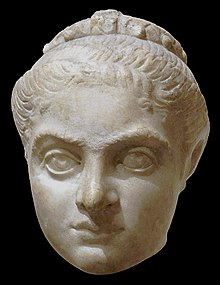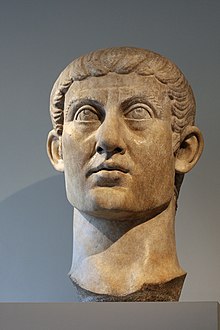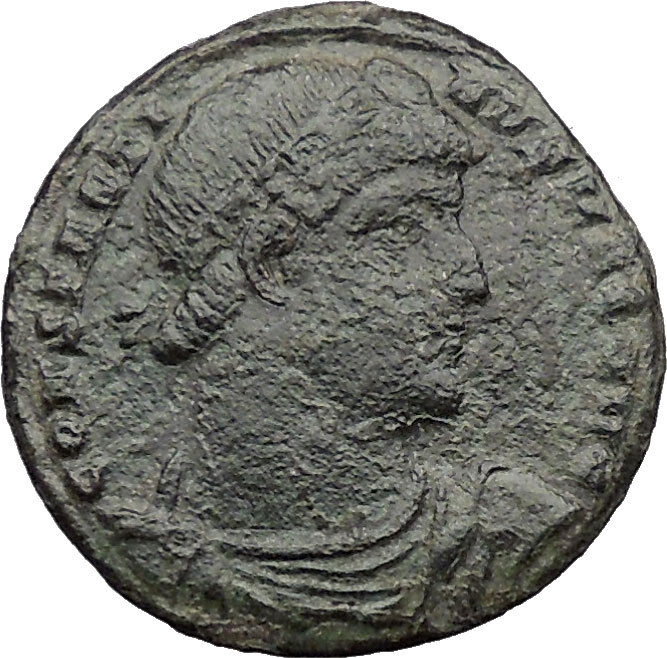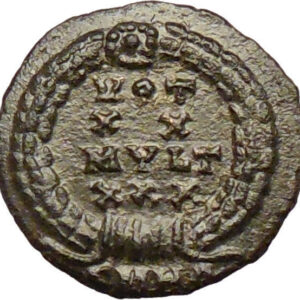|
Fausta – Roman Empress: 324-326 A.D. – wife of Constantine I ‘The Great’
Bronze AE3 / Follis 19mm (2.74 grams) Alexandria mint, struck circa 324-326 A.D.
Reference: RIC 39 (R3)
FLAV MAX FAVSTA AVG, Draped bust right.
SALVS REI PVBLICAE Exe: SMALA – Fausta, as Salus, holding her two sons, Constantine II and Constantius II.
You are bidding on the exact item pictured, provided with a Certificate of Authenticity and Lifetime Guarantee of Authenticity.
Salus (Latin: salus, “safety”, “salvation”, “welfare”) was a Roman goddess. She was the goddess of safety and well-being (welfare, health and prosperity) of both the individual and the state. She is sometimes equated with the Greek goddess Hygieia, though her functions differ considerably.
Salus is one of the most ancient Roman Goddesses: she is also recorded once as Salus Semonia, a fact that might hint to her belonging to the category of the Semones, such as god Semo Sancus Dius Fidius. This view though is disputed among scholars. The issue is discussed in the section below. The two gods had temples in Rome on the Collis Salutaris and Mucialis respectively, two adjacent hilltops of the Quirinal, located in the regio known as Alta Semita. Her temple, as Salus Publica Populi Romani, was voted in 304 BC, during the Samnite wars, by dictator Gaius Junius Bubulcus Brutus, dedicated on 5 August 302 and adorned with frescos at the order of Gaius Fabius Pictor.
The high antiquity and importance of her cult is testified by the little-known ceremony of the Augurium Salutis, held every year on August 5 for the preservation of the Roman state. Her cult was spread over all Italy. Literary sources record relationships with Fortuna and Spes. She started to be increasingly associated to Valetudo, the Goddess of Personal Health, which was the real romanized name of Hygieia.
Later she became more a protector of personal health. Around 180 BCE sacrificial rites in honour of Apollo, Aesculapius, and Salus took place there (Livius XL, 37). There was a statue to Salus in the temple of Concordia. She is first known to be associated with the snake of Aesculapius from a coin of 55 BC minted by M. Acilius. Her festival was celebrated on March 30.
Fausta – Roman Empress: 324-326 A.D.
| Second wife of Constantine the Great | Mother of Constantine II, Constantius II, Constans, Constantina (wife of Hanniballianus & Constantius Gallus) and Helena the Younger (wife of Julian II | Daughter of Maximian and Eutropia | Sister of Maxentius | Step-mother of Crispus | Daughter-in-law of Helena and (posthumously) of Constantius I | Aunt of Romulus |
 Fausta Flavia Maxima (289-326) was a Roman Empress, daughter of the Roman Emperor Maximianus. To seal the alliance between them for control of the Tetrarchy, in 307 Maximianus married her to Constantine I, who set aside his wife Minervina in her favour. Fausta Flavia Maxima (289-326) was a Roman Empress, daughter of the Roman Emperor Maximianus. To seal the alliance between them for control of the Tetrarchy, in 307 Maximianus married her to Constantine I, who set aside his wife Minervina in her favour.
Fausta had a part in her father’s downfall. In 310 Maximian died as a consequence of an assassination plot against Constantine. Maximian decided to involve his daughter Fausta, but she revealed the plot to her husband, and the assassination was disrupted. Maximian died, by suicide or by assassination, in July of that same year.
Empress Fausta was held in high esteem by Constantine, and proof of his favour was that in 323 she was proclaimed Augusta; previously she held the title of Nobilissima Femina. However three years later Fausta was put to death by Constantine, following the execution of Crispus, his eldest son by Minervina, in 326. The two deaths have been inter-related in various ways; in one, Fausta is set jealously against Crispus, as in the anonymous Epitome de Caesaribus, or conversely her adultery, perhaps with the stepson who was close to her in age, is suggested. Fausta was executed by suffocation in an over-heated bath, a mode of assassination not otherwise attested in the Roman world. David Woods offers the connection of overheated bathing with contemporaneous techniques of abortion, a suggestion that implies an unwanted, adulterous pregnancy according to Constantine’s biographer Paul Stephenson.
The Emperor ordered the damnatio memoriae of his wife with the result that no contemporary source records details of her fate: “Eusebius, ever the sycophant,mentions neither Crispus nor Fausta in his Life of Constantine, and even wrote Crispus out of the final version of his Ecclesiastical History (HE X.9.4)”, Constantine’s biographer Paul Stephenson observes.
Significantly, her sons, once in power, never revoked this order. Her sons became Roman Emperors: Constantine II reigned 337 – 340, Constantius II reigned 337 – 361, and Constans reigned 337 – 350. She also bore three daughters Constantina, Helena and Fausta. Of these, Constantina married her cousins, firstly Hannibalianus and secondly Constantius Gallus, and Helena married Emperor Julian. Apparently a genealogical claim that her daughter Fausta became mother of Emperor Valentinian I is without foundation (Valentinian I and children of Constantine I’s second marriage were born in years close to each other, i.e., they were of the same generation).
Constantine I ‘The Great’ – Roman Emperor: 307-337 A.D.
Caesar (Recognized): 306-309 A.D. | Filius Augustorum (Recognized): 309-310 A.D. | Augustus (Self-Proclaimed): 307-310 A.D. | Augustus (Recognized): 310-337 A.D. |
| Son of Constantius I ‘Chlorus’ and Helena | Step-son of Theodora | Husband of Minervina and Fausta | Father (by Minervina) of Crispus and (by Fausta) of Constantine II, Constantius II, Constans, Constantina (wife of Hanniballianus & Constantius Gallus) and Helena the Younger (wife of Julian II) | Son-in-law of Maximian and Eutropia | Brother-in-law of Maxentius | Half-brother of Constantia (w. of Licinius I) | Half-uncle of Delmatius, Hanniballianus, Constantius Gallus, Julian II, Licinius II and Nepotian | Grandfather of Constantia (wife of Gratian) |
 Constantine the Great (Latin: Flavius Valerius Aurelius Constantinus Augustus; 27 February c. 272 AD – 22 May 337 AD), also known as Constantine I or Saint Constantine (in the Orthodox Church as Saint Constantine the Great, Equal-to-the-Apostles), was a Roman Emperor from 306 to 337 AD. Constantine was the son of Flavius Valerius Constantius, a Roman army officer, and his consort Helena. His father became Caesar, the deputy emperor in the west in 293 AD. Constantine was sent east, where he rose through the ranks to become a military tribune under the emperors Diocletian and Galerius. In 305, Constantius was raised to the rank of Augustus, senior western emperor, and Constantine was recalled west to campaign under his father in Britannia (Britain). Acclaimed as emperor by the army at Eboracum (modern-day York) after his father’s death in 306 AD, Constantine emerged victorious in a series of civil wars against the emperors Maxentius and Licinius to become sole ruler of both west and east by 324 AD. Constantine the Great (Latin: Flavius Valerius Aurelius Constantinus Augustus; 27 February c. 272 AD – 22 May 337 AD), also known as Constantine I or Saint Constantine (in the Orthodox Church as Saint Constantine the Great, Equal-to-the-Apostles), was a Roman Emperor from 306 to 337 AD. Constantine was the son of Flavius Valerius Constantius, a Roman army officer, and his consort Helena. His father became Caesar, the deputy emperor in the west in 293 AD. Constantine was sent east, where he rose through the ranks to become a military tribune under the emperors Diocletian and Galerius. In 305, Constantius was raised to the rank of Augustus, senior western emperor, and Constantine was recalled west to campaign under his father in Britannia (Britain). Acclaimed as emperor by the army at Eboracum (modern-day York) after his father’s death in 306 AD, Constantine emerged victorious in a series of civil wars against the emperors Maxentius and Licinius to become sole ruler of both west and east by 324 AD.
As emperor, Constantine enacted many administrative, financial, social, and military reforms to strengthen the empire. The government was restructured and civil and military authority separated. A new gold coin, the solidus, was introduced to combat inflation. It would become the standard for Byzantine and European currencies for more than a thousand years. The first Roman emperor to claim conversion to Christianity, Constantine played an influential role in the proclamation of the Edict of Milan in 313, which decreed tolerance for Christianity in the empire. He called the First Council of Nicaea in 325, at which the Nicene Creed was professed by Christians. In military matters, the Roman army was reorganised to consist of mobile field units and garrison soldiers capable of countering internal threats and barbarian invasions. Constantine pursued successful campaigns against the tribes on the Roman frontiers-the Franks, the Alamanni, the Goths, and the Sarmatians-even resettling territories abandoned by his predecessors during the Crisis of the Third Century.
The age of Constantine marked a distinct epoch in the history of the Roman Empire. He built a new imperial residence at Byzantium and renamed the city Constantinople after himself (the laudatory epithet of “New Rome” came later, and was never an official title). It would later become the capital of the Empire for over one thousand years; for which reason the later Eastern Empire would come to be known as the Byzantine Empire. His more immediate political legacy was that, in leaving the empire to his sons, he replaced Diocletian’s tetrarchy with the principle of dynastic succession. His reputation flourished during the lifetime of his children and centuries after his reign. The medieval church upheld him as a paragon of virtue while secular rulers invoked him as a prototype, a point of reference, and the symbol of imperial legitimacy and identity. Beginning with the Renaissance, there were more critical appraisals of his reign due to the rediscovery of anti-Constantinian sources. Critics portrayed him as a tyrant. Trends in modern and recent scholarship attempted to balance the extremes of previous scholarship.
Constantine is a significant figure in the history of Christianity. The Church of the Holy Sepulchre, built on his orders at the purported site of Jesus’ tomb in Jerusalem, became the holiest place in Christendom. The Papal claim to temporal power in the High Middle Ages was based on the supposed Donation of Constantine. He is venerated as a saint by Eastern Orthodox, Byzantine Catholics, and Anglicans.
|





 Fausta Flavia Maxima (289-326) was a Roman Empress, daughter of the Roman Emperor Maximianus. To seal the alliance between them for control of the Tetrarchy, in 307 Maximianus married her to Constantine I, who set aside his wife Minervina in her favour.
Fausta Flavia Maxima (289-326) was a Roman Empress, daughter of the Roman Emperor Maximianus. To seal the alliance between them for control of the Tetrarchy, in 307 Maximianus married her to Constantine I, who set aside his wife Minervina in her favour. Constantine the Great (Latin: Flavius Valerius Aurelius Constantinus Augustus; 27 February c. 272 AD – 22 May 337 AD), also known as Constantine I or Saint Constantine (in the Orthodox Church as Saint Constantine the Great, Equal-to-the-Apostles), was a Roman Emperor from 306 to 337 AD. Constantine was the son of Flavius Valerius Constantius, a Roman army officer, and his consort Helena. His father became Caesar, the deputy emperor in the west in 293 AD. Constantine was sent east, where he rose through the ranks to become a military tribune under the emperors Diocletian and Galerius. In 305, Constantius was raised to the rank of Augustus, senior western emperor, and Constantine was recalled west to campaign under his father in Britannia (Britain). Acclaimed as emperor by the army at Eboracum (modern-day York) after his father’s death in 306 AD, Constantine emerged victorious in a series of civil wars against the emperors Maxentius and Licinius to become sole ruler of both west and east by 324 AD.
Constantine the Great (Latin: Flavius Valerius Aurelius Constantinus Augustus; 27 February c. 272 AD – 22 May 337 AD), also known as Constantine I or Saint Constantine (in the Orthodox Church as Saint Constantine the Great, Equal-to-the-Apostles), was a Roman Emperor from 306 to 337 AD. Constantine was the son of Flavius Valerius Constantius, a Roman army officer, and his consort Helena. His father became Caesar, the deputy emperor in the west in 293 AD. Constantine was sent east, where he rose through the ranks to become a military tribune under the emperors Diocletian and Galerius. In 305, Constantius was raised to the rank of Augustus, senior western emperor, and Constantine was recalled west to campaign under his father in Britannia (Britain). Acclaimed as emperor by the army at Eboracum (modern-day York) after his father’s death in 306 AD, Constantine emerged victorious in a series of civil wars against the emperors Maxentius and Licinius to become sole ruler of both west and east by 324 AD.




